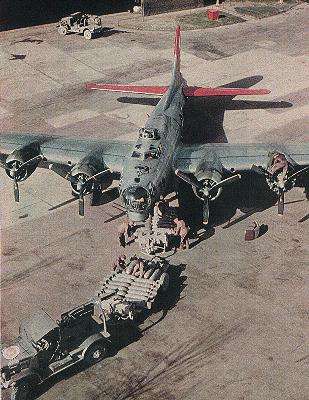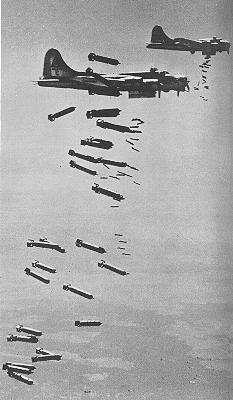
|
The First American Raids |
 |
||||||||
|---|---|---|---|---|---|---|---|---|---|---|
 |
 |
 |
 |
 |
 |
 |
 |
 |
 |
| Additional Notes: |  |
 |
|
A B-17G being loaded at an English base with 300 lb. bombs. |
In June 1944, the Americans dropped 120,000 tons of bombs on Germany. | |
|
During the summer on 12 June 1942, American air power made its European debut. Colonel Harry Halverson led thirteen B-24s on a first daring, long-distance raid against the oil refineries at Ploesti, Rumania, taking off from Egypt more than 1,000 miles away. Enroute, one B-24 turned back due to frozen fuel lines. The first raid on Ploesti inflicted only minimal damage to the Romanian refineries and German oil supply. The mission however, represented a significant step for American air power. Not only were these the first bombs dropped over Europe by Americans, it was a demonstration of the great range the Consolidated B-24 Liberator. Of the twelve B-24s that reached Ploesti, six landed safely in Iraq and two landed in Syria. Four bombers were forced to land in Turkey where the aircraft were seized and the crews interned. The only injuries were minor, and not a single man was lost or killed in action. In England, the first American mission took place on the 4th of July, 1942. Six American air crews flying A-20 Boston bombers (borrowed from the RAF), joined six British crews on a low-level raid against air bases in Holland. The Germans were warned by radio from a picket ship off the Dutch coast, and two of the American bombers were shot down enroute. The bombardiers of two of the other planes were so confused by the camouflaged targets that they failed to drop their bombs at all. More auspicious was a raid on 17 August 1942 against the railroad yards at Rouen. A dozen B-17 Flying Fortresses loaded with 300 lb. bombs, completed their mission without losses. In the fall, the North African invasion diverted planes and men and temporarily stalled the buildup of US air strength in England, but as the Eighth continued to stab at the enemy, American crews matched the courage and ability of veterans. On 21 August 1942, twelve B-17s, turning back from a canceled mission against Rotterdam, were jumped by more than twenty German fighters. The Americans fought their way back to England, but in one bomber, the pilot was injured and the copilot killed. The bombardier, who had been washed out of flying school, took over the controls and flew the plane back home on two engines. | ||
©Larry Dwyer. The Aviation History On-Line Museum.
All rights reserved.
Created September 8, 1996. Updated January 20, 2023.